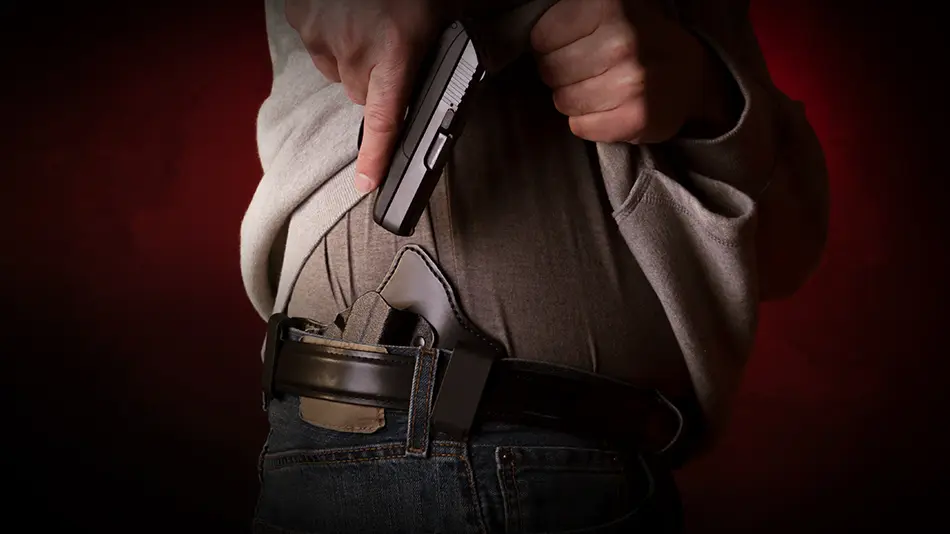
Can a judge sign an order allowing police to seize your guns without you even breaking a single law? In recent years, there has been a nationwide push for “extreme risk protective orders” or “red flag” laws specifically designed to remove firearms from people accused of engaging in conduct or making statements that others may deem “dangerous.” You’ve probably heard about them in the news recently; but what are they? What do you need to know about them, and how could they be used to take away your Second Amendment rights? Let’s look at the history of these laws and how Colorado uniquely falls on this hotly debated area.
The History of Red Flag Laws
Red flag laws entered prominent national discourse in 1999 when Connecticut passed the first one of its kind because of a mass shooting at the Connecticut Lottery headquarters. Lawmakers in Connecticut intended this law to target individuals with specific mental health conditions and prevent them from accessing firearms.
More recently, on February 14, 2018, a 19-year-old former student opened fire at Marjory Stoneman Douglas High School in Parkland, Florida, horrifically killing 17 people and injuring 17 others. There was an immediate national outcry to “do something” to stop what the media has frequently dubbed “gun violence.” When information emerged that the shooter had documented mental health issues, lawmakers across the country began pushing for laws to take away guns from individuals whose behavior raised a “red flag” that they could be a threat to themselves or others.
In theory, the purpose of these laws is to identify an individual who exhibits early warning signs of danger and prevent a criminal act from occurring by preemptively disarming them. However, there’s an obvious irony: with red flag legal proceedings, the person’s firearms are seized, but the individual may be quickly released back into society, free to pursue whatever misdeeds they might choose to do.
Many of the states with red flag laws currently on the books allow for an enforceable court order that prevents the person from owning, purchasing, possessing, or transporting firearms and ammunition for a specified period of time. Several jurisdictions also allow the extension of these orders if the affected individual is still “deemed a threat.”
For example, under California’s red flag law (called a “gun violence restraining order”), a person could be prohibited from owning, purchasing, possessing, or transporting firearms and ammunition initially for between one and five years, with the potential for the order to be renewed and extended indefinitely. California Penal Code §§ 18170-18197 lays out the process by which any qualifying person may ask to extend the red flag order within three months of its expiration. The order will be extended if the court finds that the person still poses a significant danger of causing personal injury to themselves or another by controlling, owning, purchasing, possessing, or receiving a firearm, ammunition, or magazine, and all other conditions for renewal are satisfied.
A Californian subject to a red flag order may petition the court only once per year and ask for it to be lifted; which could entail another costly and time-consuming legal proceeding.
As of the publish date of this article, 19 states and the District of Columbia have enacted versions of red flag laws. How do things stand for Colorado?
Red Flag Laws in Colorado
Colorado has a red flag law currently on the books called the “Deputy Zackari Parrish III Violence Prevention Act,” which was enacted after Douglas County Deputy Zackari Parrish was shot and killed in the line of duty by a mentally unstable man. An “extreme risk protection order” (commonly called an “ERPO”) is the term used in the Colorado Revised Statutes to refer to the court order that may be imposed in certain circumstances under Colorado’s red flag law.
An ERPO orders a person to immediately surrender any firearm in their custody, control, or possession, and any concealed carry permit issued to that person. Further, the restrained party (“respondent”) is prohibited from purchasing, possessing, receiving, or attempting to purchase or receive a firearm while the order is in effect. C.R.S. § 13-14.5-105. A family or household member of the respondent or a law enforcement officer or agency may initiate the process to seek an ERPO. C.R.S. §§ 13-14.5-103, 13-14.5-104.
Issuance of an ERPO is typically a two-step process. First, a person or agency eligible under the statute (“petitioner”) may seek a temporary ERPO. If issued, a temporary ERPO will order the respondent to surrender their firearms and concealed carry permit and prohibit the person from possessing or attempting to possess firearms while the temporary order is active. Second, the court will schedule a subsequent hearing to determine whether the temporary ERPO should be extended for an additional 364 days. The temporary ERPO expires on the date and time of that hearing. C.R.S. § 13-14.5-103.
The hearing to determine whether a temporary ERPO will be issued is an ex parte proceeding, meaning the court will only hear information provided by the person seeking the order. Generally speaking, to issue a temporary ERPO, the court must find by a preponderance of the evidence (meaning more likely than not) that the respondent poses a significant risk of causing personal injury to themself or others in the near future by having in his or her custody or control a firearm, or by purchasing, possessing, or receiving a firearm. C.R.S. § 13-14.5-103.
The subsequent hearing to determine whether a 364-day ERPO will be granted must be held within 14 days of the issuance of the temporary ERPO. At this hearing, the burden of proof is elevated and the court must now find by clear and convincing evidence that the respondent poses a significant risk of causing personal injury to themself or others by having in their custody or control a firearm, or by purchasing, possessing, or receiving a firearm. In making this determination, the court may consider any relevant evidence, and the respondent will have the opportunity to challenge the petitioner’s allegations. C.R.S. § 13-14.5-105.
If the petitioned meets their burden, and the court issues either a temporary or 364-day ERPO, the court will then order the respondent to surrender all firearms and any concealed carry permit previously issued to the respondent. The respondent then has the option to either sell or transfer possession of the firearms to a federally licensed firearms dealer (“FFL”) or arrange for the storage of the firearms by a law enforcement agency. C.R.S. § 13-14.5-108. If firearms are surrendered or stored with a law enforcement agency, a full inventory will be taken, and the agency shall issue a receipt to the respondent.
During the effective period of the ERPO, a respondent may submit only one written request for a hearing to terminate a 364-day ERPO and has the burden to prove by clear and convincing evidence that they no longer pose a significant risk of causing personal injury to themself or others by having in their custody or control a firearm or by purchasing, possessing, or receiving a firearm. On the other hand, a petitioner may request a renewal of an ERPO at any time within 63 days before expiration of the order and will be held to the same burden of proof. C.R.S. § 13-14.5-107.
Upon termination or expiration of a temporary or 364-day ERPO, the law enforcement agency or FFL holding the firearms must return them within three days of a respondent’s request, but prior to doing so must first confirm the respondent is eligible to own or possess a firearm under federal and state law through a criminal history record check and must verify with the court that the order has been terminated or expired. If a respondent fails to claim their previously surrendered firearms within one year from the date of the expiration of the temporary ERPO or 364-day ERPO, whichever is later, the law enforcement agency that maintained custody of the firearms is required to dispose of them in accordance with that agency’s policies and procedures. C.R.S. § 13-14.5-109.
A person who violates an ERPO commits a class 2 misdemeanor. C.R.S. § 13-14.5-111. Additionally, a petitioner who files a malicious or false petition for a temporary or 364-day ERPO may also be subject to criminal prosecution. C.R.S. § 13-14.5-113.
Given the extremely short period of time between issuance of a temporary ERPO and the 364-day ERPO hearing, U.S. LawShield members should immediately call U.S. LawShield and ask to speak to their Independent Program Attorney upon being served with an ERPO. The subsequent hearing is the best opportunity to challenge the allegations and avoid issuance or continuation of an ERPO. As such, it is critical to use the few days prior to this hearing to prepare to challenge the allegations. Indeed, it is nearly impossible to convince a court after the fact that a previously ordered ERPO should be terminated early.
Potential Legislation in Colorado
Colorado’s red flag law was passed in 2019 through HB19-1177 and, as such, is a rather new addition to the Colorado Revised Statutes. Indeed, this law has only been effective for a little over a year now. There have been efforts to amend or repeal this law; however, none have experienced any success. It is not expected that the Colorado Legislature will reexamine this law in the near future.
If you have questions about red flag laws or any other gun-related legislation, call U.S. LawShield and ask to speak to your Independent Program Attorney.
The information provided in this publication is intended to provide general information to individuals and is not legal advice. The information included in this publication may not be quoted or referred to in any other publication without the prior written consent of U.S. LawShield, to be given or withheld at our discretion. The information is not a substitute for, and does not replace the advice or representation of a licensed attorney. We strive to ensure the information included in this publication is accurate and current, however, no claim is made to the accuracy of the information and we are not responsible for any consequences that may result from the use of information in this publication. The use of this publication does not create an attorney-client relationship between U.S. LawShield, any independent program attorney, and any individual.





Leave A Comment